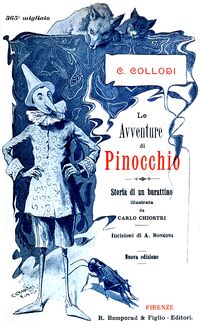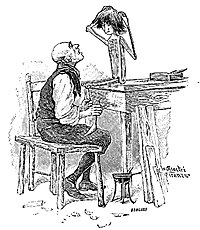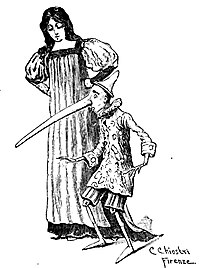
Title page of an Italian edition from 1902.
The Adventures of Pinocchio (Italian: Le avventure di Pinocchio; often referred to in English simply as Pinocchio) is a children's comedy fantasy novel of thirty-six chapters by the Italian author Carlo Collodi. The first fifteen chapters were originally serialized in the children's weekly magazine Giornale per bambini between July 7, 1881 and February 18, 1882 under the title Storia di un burattino ("Story of a Puppet"). Those chapters were published again in book form, together with twenty-one additional chapters, in 1883.
The novel's title character and protagonist is a living wooden puppet, carved by a toy maker named Gepetto who takes him as his adoptive son. Pinocchio is initially disobedient and mischievous. He abandons his father and goes off in search of adventure. The original newspaper serialization ended with Pinocchio being hanged for his many misdeeds. In the expanded novel version, Pinocchio is saved by a fairy in the sixteenth chapter. The fairy educates Pinocchio and manages to get him to change his ways. As a reward for his good behavior, Pinocchio is eventually transformed into a real boy.
The novel has been translated into some two hundred and fifty different languages. There have been various musical, stage, television and film adaptations of The Adventures of Pinocchio, the best known of which continues to be the 1940 animated film Pinocchio from Walt Disney. The idea of somebody's nose growing when he or she tells a lie, which was introduced in The Adventures of Pinocchio, has entered popular mythology.
Plot[]

Pinocchio steals Gepetto's wig before the old man has even finished carving him. 1902 illustration by Carlo Chiostri and A. Bongini.
A carpenter finds a talking piece of wood which he gives to his friend, a poor old man named Gepetto. Gepetto carves the piece of wood into a puppet which he calls his son and names Pinocchio. However, as soon as he can walk, Pinocchio runs away. He is stopped by a policeman but the policeman assumes that Gepetto had been mistreating him and the old man is arrested. Back at home, a talking cricket appears. The Cricket warns Pinocchio of the dangers of disobedience and living only for pleasure but Pinocchio throws a mallet at the insect and kills it. The puppet falls asleep with his feet in front of the fire. He wakes up the next morning to find that his feet have burned away. Gepetto, having been released from jail and returned home, makes new feet for Pinocchio. Out of gratitude, the puppet agrees to go to school.

Stromboli from Disney's 1940 Pinocchio was based on the character Mangiafuoco from the original novel.
On the way to school, Pinocchio notices a puppet theater. He sells his school book so that he can buy a ticket for the show. The puppets on stage notice Pinocchio in the audience. The puppetmaster Mangiafuoco[1] is angry because his puppets have been distracted from their performance. He threatens to use Pinocchio as firewood to continue roasting his mutton. Pinocchio pleads for his life. Mangiafuoco agrees to spare him and says that he will use one of his own puppets, Harlequin, for firewood instead. On hearing this, Pinocchio begs Mangiafuoco to spare Harlequin and burn him instead. Mangiafuoco rewards Pinocchio by giving him five gold coins to give to his father and declares that he will eat his mutton partly raw.

The Cat and the Fox as they appear in Disney's 1940 Pinocchio.
On his way home with the five gold coins, Pinocchio encounters the two tricksters, the Fox and the Cat. The Fox pretends to be lame and the Cat pretends to be blind. The two tell Pinocchio that he should plant his five gold coins in the Field of Miracles near the city of Catchfools, where they will grow into a gold coin tree. The three head off together and stop at an inn. The Fox and the Cat leave in the middle of the night, forcing Pinocchio to use one of his gold coins to cover their bill. Pinocchio continues on his way to Catchfools but finds that he is being pursued by two bandits, who are really the Fox and the Cat in disguise. Pinocchio arrives at the cottage of the Fairy with Turquoise Hair[2] but the two bandits catch up with him and hang him from a tree. They eventually get tired of waiting for Pinocchio to die and leave.

The Fairy knows that Pinocchio is lying because of his growing nose. 1902 illustration by Carlo Chiostri and A. Bongini.
The Fairy has Pinocchio brought to her house and asks three doctors, one of whom is the Ghost of the Cricket which Pinocchio killed earlier, if the puppet is dead or alive. The Ghost of the Cricket says that the puppet is alive but has been disobedient and abandoned his father. The Fairy nurses Pinocchio back to health. When she asks him what happened to the gold coins he was given, Pinocchio lies. The Fairy informs him that she knows he is lying because his nose is growing. She eventually has to call on a thousand woodpeckers to cut the nose back down to size.
The Fairy tells Pinocchio that Gepetto can come to live with them. The puppet goes to fetch his father but meets up with the Fox and the Cat again on the way. The two tricksters remind him about the Field of Miracles near the city of Catchfools and the three set off for it again. Pinocchio buries the gold coins in the field and is told to come back in twenty minutes, when the coins will have grown into a tree. When Pinocchio returns, he finds that there is no tree and the coins are no longer there either. Realizing what has happened to him, Pinocchio reports the crime but is himself locked up for being foolish. The puppet is released when the Emperor of Catchfools declares an amnesty to celebrate his victory in battle.
Pinocchio returns home to the cottage of the Fairy with Turquoise Hair but finds that the cottage is no longer there and a gravestone stands in its place. Pinocchio believes that the Fairy must have died of grief after he left and is deeply saddened. A pigeon informs Pinocchio that Gepetto is building a boat to go out in search of him. The bird carries Pinocchio to the coast, where Pinocchio sees Gepetto in the boat. The puppet tries to swim out to the old man but is carried off by a wave and sees Gepetto being swallowed by a shark.
The puppet is carried by a dolphin to the Island of Busy, where he finds that he has to work in order to get food. Pinocchio agrees to carry a jug for a woman who turns out to be the Fairy with Turquoise Hair. The Fairy tells Pinocchio that she will be his mother and that if he attends school and behaves himself, he will eventually become a real boy.

Lampwick and Pinocchio see that they both have donkeys' ears. 1902 illustration by Carlo Chiostri and A. Bongini.
Apart from the day on which he is tricked into not going to school and narrowly avoids being eaten by the Green Fisherman, who thinks that a puppet is a new kind of fish which he has never tried before, Pinocchio behaves well and proves himself to be an excellent student. One day, the Fairy informs him that he will become a real boy the next day and that he can invite all of his friends to a party. When Pinocchio goes to see one of his friends, Lampwick,[3] the boy tells him that he is leaving for Toyland where nobody ever works and everybody has fun all day. Pinocchio ignores the Ghost of the Cricket's warning and takes the coach to Toyland with Lampwick. The two have fun for five months, then wake up one morning to find that they have donkeys' ears. As a result of five months of laziness, Pinocchio and Lampwick are changed into donkeys. Pinocchio is sold to a circus, where he performs tricks until he breaks his leg. The lame donkey is sold to a man who wants to drown it so that he can use its skin to make a drum. When Pinocchio is lowered into the sea on a rope, the fishes eat away his donkey skin, leaving him as a puppet again.

Gepetto and Pinocchio escape from the shark's mouth. 1902 illustration by Carlo Chiostri and A. Bongini.
In spite of the warnings from a goat with turquoise hair, Pinocchio is swallowed by the same shark which had swallowed Gepetto earlier. The puppet is reunited with his father and discovers that the shark has asthma, which means that it has to sleep with its head above the water. The two escape from the shark's mouth while the fish is sleeping near to shore. They pass the Fox and the Cat, the Fox having now really become lame and the Cat really having gone blind. Pinocchio refuses to help them, saying that they were wicked and deserve their misfortune.
Pinocchio and Gepetto arrive at a cottage which is home to the Ghost of the Cricket. The Ghost says that he got the house from a goat with turquoise hair and that the old man and the puppet can stay there with him. Pinocchio gets a job working for a farmer, recognizing the farmer's dying donkey as his old friend Lampwick. The puppet works hard and saves forty pennies, which he intends to spend on a new suit.
Having gone to town to buy his new suit, Pinocchio hears that the Fairy is ill and decides to give the forty pennies to her instead. That night, Pinocchio dreams that the Fairy with Turquoise Hair comes and kisses him. When he awakes, he finds that his old wooden body is lying lifeless on a chair, he has become a real boy, he has a new suit of clothes and a purse with forty gold coins in it.
Adaptations[]

Still from the unfinished 1936 Italian animated film Le avventure di Pinocchio.
The Adventures of Pinocchio has been adapted numerous times for other media. Some adaptations have followed Collodi's original novel closely whereas others have been much freer. There have been stage plays, musicals, ballets and operas based on the novel. There have been several television specials and series, both live-action and animated, adapted from the novel. There are at least fourteen English-language films based on The Adventures of Pinocchio as well as other movie versions in languages including Italian, French, Russian and Japanese.
In 1936, work began on Le avventure di Pinocchio, which would have been the first animated film adaptation of the novel and the first feature-length animated cartoon from Italy, but the film was never completed. The film's script and a few stills from the movie survive but the film is now considered lost.
The best known adaptation of the novel continues to be the Disney 1940 animated film Pinocchio. The cartoon is a very loose adaptation of Carlo Collodi's novel but it is considered a great work of art in its own right. The movie has been deemed culturally significant by the Library of Congress and selected for preservation by the United States National Film Registry.
Pinocchio, a live-action and CGI remake of the 1940 Disney animated film of the same name, began streaming on Disney+ on September 8, 2022. The film stars Tom Hanks as Gepetto. It was directed and co-written by Robert Zemeckis.
The Mexican-American stop-motion animation film Pinocchio, directed by Guillermo del Toro and Mark Gustafson, had its world premiere at the BFI London Film Festival on October 15, 2022 and had a limited theatrical release in the United States on November 9, 2022. It won the 2023 Academy Award for Best Animated Feature Film.

1992 Russian stamp which depicts Buratino.
Russian author Aleksey Nikolayevich Tolstoy (1883-1945) claimed to have owned a copy of The Adventures of Pinocchio as a child but lost it. When he tried to tell the story to his own children from memory, he eventually created a new children's novel called The Golden Key in which the protagonist is renamed Buratino (from the Italian word burattino which means "puppet"). The novel deals with what happens when the evil puppet master Karabas Barabas (equivalent to Mangiafuoco in The Adventures of Pinocchio) finds out that there is a secret door in the house of Papa Carlo (equivalent to Gepetto from Collodi's novel) which can only be opened with a special golden key. The rest of the narrative is mostly concerned with the efforts of Buratino and his friends to locate the missing key. Buratino became a very popular character in the USSR and remains so in countries of the former Soviet Union today. Movie adaptations of The Golden Key were released in 1959 and 1975.
See akso[]
Footnotes[]
- ↑ "Mangiafuoco" is Italian for "fire-eater".
- ↑ The original Italian name of the character is La Fata dai Cappelli Turchini (the Fairy with Turquoise Hair). Some English-language translations and adaptations of The Adventures of Pinocchio describe the fairy's hair as being blue. The character is probably now best known in English-speaking countries as the Blue Fairy, the name which she is given in the 1940 Disney film Pinocchio.
- ↑ In the original Italian version of the novel, Lampwick is called Lucignolo. He is called Candlewick in some English translations of the book.
External links[]
- Versions of Carlo Collodi's The Adventures of Pinocchio in Italian and English on Wikisource.
- Free public domain audiobooks of The Adventures of Pinocchio in Italian and English from LibriVox.
- Pinocchio Wiki.
